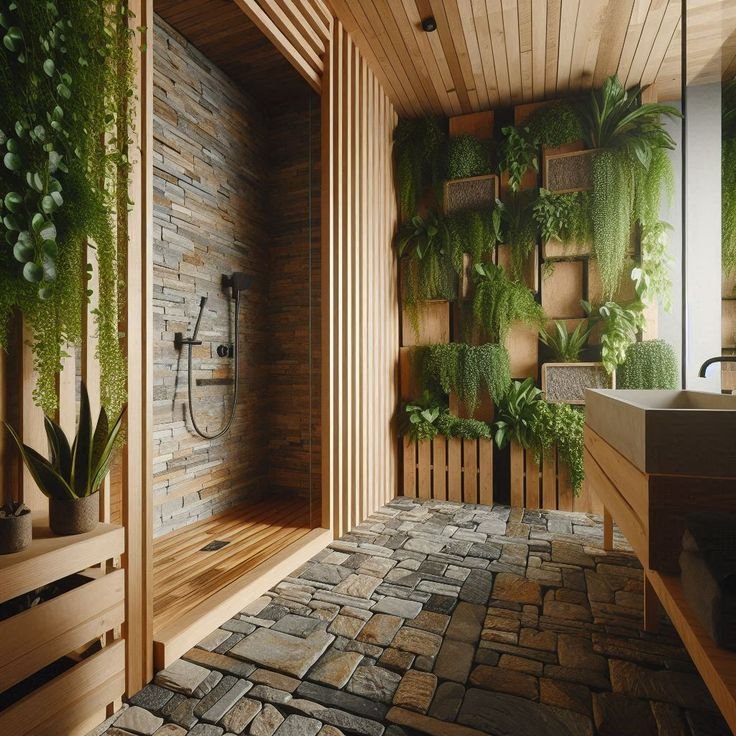Sustainable Bathroom Makeover: 10 Eco-Friendly Tips for a Greener Bathroom

Introduction:
The bathroom, often overlooked in the quest for sustainability, is an essential part of the home that can have a substantial environmental impact. From water usage to energy consumption and waste generation, the bathroom is a space where small changes can add up to significant improvements for both your health and the planet. Making your bathroom eco-friendly doesn’t mean sacrificing comfort or style; it’s about integrating thoughtful, sustainable choices into everyday routines.
In this guide, we’ll explore 10 eco-friendly bathroom makeover ideas designed to reduce waste, conserve resources, and promote a cleaner, healthier environment. By incorporating these tips into your daily life, you can create a space that supports sustainable living without compromising on luxury or convenience. From water-saving techniques to choosing environmentally friendly products, let’s dive into how you can make your bathroom a model of sustainability, one step at a time.
10 Tips for a Greener Bathroom
1. Install Low-Flow Toilets and Faucets
One of the most significant ways to reduce your bathroom’s environmental impact is by conserving water. Toilets are one of the largest water users in a household, and switching to a low-flow toilet can reduce water consumption by up to 60%. Similarly, low-flow faucets and showerheads help reduce water waste without sacrificing performance.
Look for models that are WaterSense certified, as these fixtures meet strict efficiency standards set by the U.S. Environmental Protection Agency (EPA). These small adjustments can help save thousands of gallons of water annually, which is crucial in the fight against water scarcity.
2. Switch to Eco-Friendly Toiletries
Another area in which you can reduce waste in your bathroom is by choosing eco-friendly toiletries. Traditional personal care products often come in single-use plastic packaging, contributing to landfill waste and environmental pollution. By opting for biodegradable, reusable, or recyclable options, you can make a big difference.
Consider using bar soap instead of liquid soap in plastic bottles, and choose shampoo bars over plastic-bottled shampoos. For toiletries like toothbrushes, try switching to bamboo alternatives instead of plastic ones, which can take centuries to decompose.
3. Use Non-Toxic and Eco-Friendly Cleaning Products
Many conventional cleaning products contain harmful chemicals that can be toxic to both your health and the environment. Switch to natural, non-toxic cleaning products made from simple ingredients like vinegar, baking soda, and essential oils. These eco-friendly alternatives are not only safer for your family but also more effective at cleaning without leaving behind harmful residues.
By making your own cleaning products, you can also reduce packaging waste and save money. Microfiber cloths are another great alternative to paper towels, as they are reusable and last much longer.
4. Embrace Energy-Efficient Lighting
Lighting in the bathroom can contribute significantly to your energy consumption. To reduce your energy usage, consider switching to LED light bulbs, which consume up to 80% less energy and last longer than traditional incandescent bulbs. This simple swap will help lower your electricity bill while reducing your carbon footprint.
In addition to energy-efficient bulbs, try installing motion-sensor lights or timers to ensure lights aren’t left on unnecessarily. This approach ensures that energy is only used when needed, contributing to overall energy savings.
5. Opt for Sustainable Bathroom Materials
When remodeling or upgrading your bathroom, consider choosing sustainable materials that have a lower environmental impact. Recycled glass, bamboo, and reclaimed wood are all great options for bathroom surfaces, cabinetry, and decor. Not only are these materials renewable, but they also tend to be durable, reducing the need for frequent replacements.
Additionally, choosing tiles made from recycled content or natural stone is another way to minimize your bathroom’s environmental footprint. Many companies now offer sustainable alternatives that still offer high-quality aesthetics and performance.
6. Replace Plastic Shower Curtains with Fabric Alternatives
Plastic shower curtains are a major contributor to bathroom waste. They are often made from PVC, a harmful plastic that can leach toxic chemicals into the environment. To make your bathroom greener, replace plastic curtains with fabric alternatives made from organic cotton, hemp, or other eco-friendly materials.
These fabric curtains are washable, reusable, and more durable than their plastic counterparts. They are also free from harmful chemicals, making them safer for you and the environment.
7. Use a Water-Efficient Showerhead
Showerheads are another significant source of water consumption in the bathroom. Installing a water-efficient showerhead can significantly reduce water waste while still providing a satisfying shower experience. Look for models that use less than 2.5 gallons per minute (gpm) of water, and consider showerheads with a built-in aerator that reduces water flow without sacrificing pressure.
In addition to saving water, installing a low-flow showerhead can help reduce your heating costs by using less hot water, making it a win-win for both your utility bills and the planet.
8. Choose Reusable Towels and Washcloths
Instead of using disposable paper towels or wipes, switch to reusable towels and washcloths made from organic cotton or other sustainable materials. These items can be washed and reused for years, reducing the waste generated from single-use products.
You can also switch to biodegradable bath sponges or natural loofahs instead of synthetic sponges, which often contain plastic fibers that do not decompose. These small changes will help you cut down on bathroom waste and minimize your environmental footprint.
9. Install a Greywater Recycling System
A greywater recycling system collects wastewater from your sinks, showers, and bathtubs and recycles it for use in non-potable applications like flushing toilets or watering your garden. This system significantly reduces your water consumption by allowing you to reuse water that would otherwise be wasted.
While installing a greywater system can be an upfront investment, it can pay off in the long run by reducing both your water and sewage bills. It’s a sustainable solution that helps conserve one of the world’s most precious resources.
10. Invest in a Composting Toilet
For those looking for a more advanced eco-friendly bathroom upgrade, consider installing a composting toilet. Unlike traditional toilets that rely on large quantities of water to flush waste, composting toilets use minimal water and convert waste into compost through natural biological processes.
Composting toilets are ideal for homes with water scarcity concerns, as they help conserve water and create nutrient-rich compost for gardening. They are especially beneficial for off-grid or eco-conscious homeowners who want to reduce their ecological footprint.
Conclusion:
Creating a sustainable bathroom is all about making conscious choices that promote environmental responsibility without sacrificing convenience or comfort. By implementing these 10 tips, you can reduce waste, conserve water and energy, and create a healthier living space for both you and the planet. From water-saving fixtures to eco-friendly toiletries and energy-efficient lighting, each small change makes a meaningful contribution to your overall sustainability efforts.
Sustainable living begins with simple changes that can have a lasting impact. Your bathroom makeover doesn’t need to be overwhelming or costly; it’s about taking one step at a time and making mindful choices that will benefit the environment, your family, and your future. Start small, and soon your bathroom will not only be a space of relaxation and rejuvenation, but also one that reflects your commitment to sustainability and eco-conscious living.






